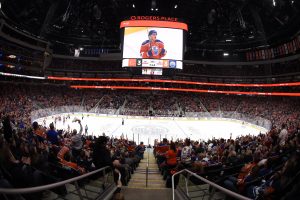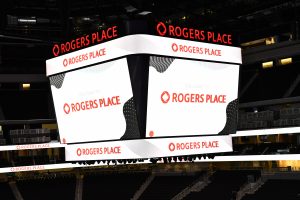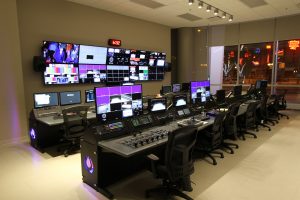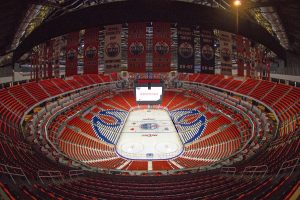Edmonton Oilers Embark on Rogers Place Era With NHL’s Largest Videoboard
The NHL dynasty moved into its new home prior to the 2016-17 season after more than 40 years at the former Northlands Coliseum
Story Highlights
As the longtime home of the Edmonton Oilers, Rexall Place (originally Northlands Coliseum) had seen the iconic franchise hoist five Stanley Cup Champion banners to the rafters in less than a decade. It was also beginning to show its age. The Oilers needed an arena worthy of housing a dynasty, one that would safeguard the team’s future in the city they’ve called home since 1971. They’ve found that in Rogers Place.
The 18,500-seat arena opened in September, hosting several concerts before settling in for the current NHL season. As the Oilers fight for their first playoff berth since 2005-06 (the team is currently 30-19-8), the Oilers Entertainment Group continues to demonstrate the same dedication to its passionate and steadfast fanbase as it did at Rexall Place.
“[Our philosophy] is hockey first: respect for hockey and respect for the Oilers,” says Rich Meyers, director, event presentation, Oilers Entertainment Group. “For the crowd at an Oilers game, the hockey comes first. They’re here to watch the game and have the best experience possible. Replays are top priority; if there’s anything that’s even remotely replay worthy, that takes priority over in-game features. … Certainly, we’re fan-centric: we try to showcase our fans when we don’t have replays to show. It’s been a decade since we made the playoffs, but the passion that the fans show for the sport is truly unmatched to anywhere else — their dedication and their loyalty — and we try to get them up on the board as much as possible.”
That effort to show every replay and as many fan reactions as possible is easier than ever, thanks to Rogers Place’s impressive new center-hung videoboard. Measuring 46 ft. wide, 36 ft. high, and 46 ft. deep and weighing in at a whopping 90,000 lb., it’s the largest videoboard of its kind in the NHL.
“It all started with our owner Mr. [Daryl] Katz basically throwing down the gauntlet, saying what is possible? What can we do to make the board be spectacular?” says Vernon Mason, director, production systems and services, Aquila Productions, which served as technology consultant to arena architect HOK before becoming part of Oilers Entertainment Group. “We essentially came upon a couple key things: it needed to be large, it needed to be high definition, it needed to be spectacular.
“Certainly,” he continues, “it needed to have a main replay window, it needed to have a display for virtual scoring, it needed to have a display for crowd pumpers and sponsorship, it needed to have a crown with the name of our building, Rogers Place. Once we took all of those basic requirements, we eventually came up with a 46-ft.-wide by 46-ft.-deep by 36-ft.-high scoreboard.”
Mason served as lead technology consultant on the videoboard project, working with LED manufacturer Prismview Yesco (a subsidiary of Samsung Electronics) to bring the design to fruition. The final product includes a main 1,920×1,080 6-mm LED replay window stretching 38 ft. by 22 ft., with rings above and below for crowd pumpers, sponsorship, virtual scoring, and penalty information.
To power the massive videoboard, Rogers Place carved out a video-control room on the venue’s event level and worked with local systems integrator Matrix Video Communications to outfit the space. The 1080i control room features a 4M/E Ross Video Acuity switcher (80 input, 40 output), eight XPression character generators (two for on-air applications, six to provide content to LED displays), Inception social-media system, and Incoder transcoding and ingest engine; a 207 x 224 Imagine Communications Platinum IP3 router with integrated multiviewer; two Evertz DreamCatcher replay systems (12 total inputs, four total outputs); a Yamaha M7CL-48 audio console; and Avid Media Composter editing with ISIS storage, Interplay MA, Media Director, and Media Central UX. An Imagine Communications InfoCaster IPTC system drives nearly 1,300 TVs throughout the building.
On game days, Oilers Entertainment Group deploys five Sony cameras with Fujinon lenses for the videoboard show: four HSC-100 RF cameras (two in a hard-camera configuration and two handheld) and a handheld PXW-X500 EFP camera with a Vislink wireless system. The team also takes approximately 20 feeds from the broadcast truck, as well as a few NHL-provided feeds, such as in-net cameras. Six Bradley Cam-Ball robotic PTZ cameras are installed in the players’ tunnel, in the game-presentation booth, in the media press-conference room, and under the clock.
In addition, Rogers Place installed a one-of-its-kind camera system to the underside of the videoboard. Working with German manufacturer Blackcam, Oilers Entertainment Group mounted a Sony HDC-P1 camera with a Fujinon broadcast lens on a Blackcam B40 robotic camera dolly and suspended the system beneath the videoboard so that it runs the length of the structure.
“It’s like a rail cam that runs under the clock, so it’s a little different than a fixed PTZ camera,” says Keith Hough, manager of A/V production for Rogers Place, who worked alongside Mason on the Aquila design team throughout the arena construction. “It gives us a slightly different look from the camera, [as it is] actually moving parallel to the ice surface.”
The wide variety of screens throughout Rogers Place isn’t the only canvas at the Oilers’ disposal; rather, the team has the entire bowl at its fingertips, thanks to an investment in on-ice projection. The arena installed 12 30K Barco HDF-W30 Flex Projectors in six banks, which are powered by Coolux (Christie) Pandora’s Box Ice Projection System.
“[Being able to] use the entire bowl as a canvas, I think, challenges us in the way we interact with the different canvases and create one [show]. It certainly has brought a different dynamic to our presentation,” says Meyers. “We’ve just scratched the surface on what we can do.”




